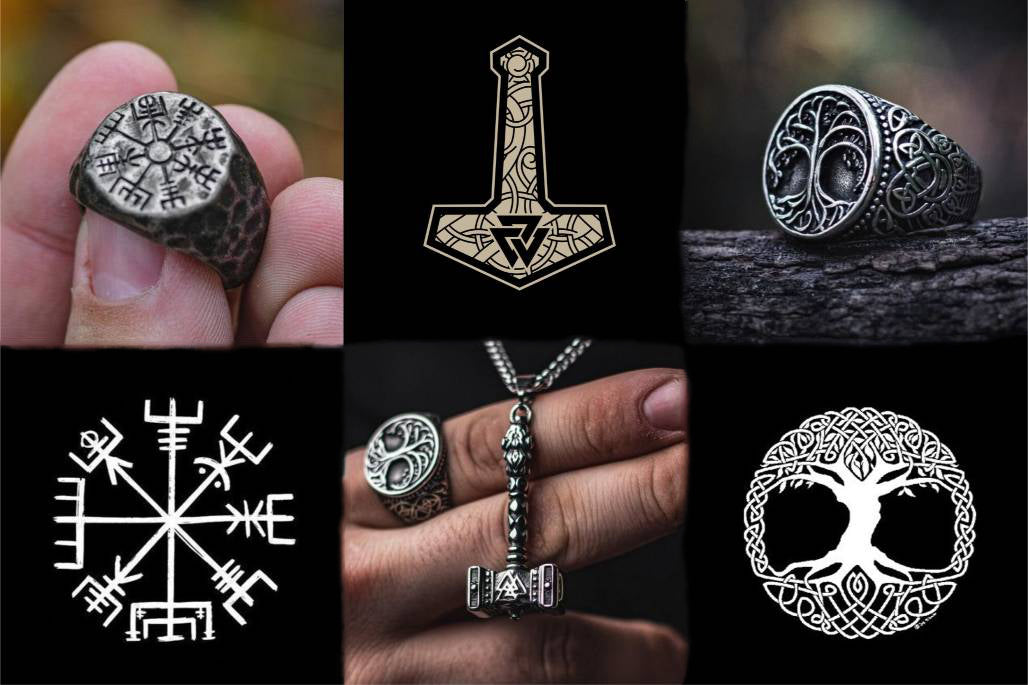Immersion in the Viking Strength Symbols: Journey Through Norse Mythology
The Vikings, seafarers and warriors from Scandinavia, dominated from the 8th to 11th centuries. Their distinctive culture was rich with myth and symbolism that embodied strength, resilience, courage, and honor. This blog navigates through these evocative symbols, shedding light on the enthralling narratives of Viking history.

Thor: The Norse God of Strength
Regarded as the physical embodiment of strength, Thor, the God of Thunder, held a significant place in Viking mythology. Renowned for his fiery red hair, formidable presence, and mighty hammer, Mjölnir, Thor was not merely a character but an esteemed emblem in the vast Norse pantheon. His stature was honored as a guardian of humankind, a beacon in the face of adversity.
His ceaseless bravery, demonstrated through thrilling tales of combating formidable adversaries, served as a source of profound inspiration for the Vikings. Thor's remarkable strength and unparalleled power were widely revered, establishing him as the paragon of strength and the epitome of the Viking's unwavering resilience and unwearied vigor.
Vegvisir: The Emblem of Resilience
The Vegvisir, or the runic compass, epitomizes resilience and guidance in the intricate Norse mythological cosmos. Envisioned as a complex runic design, this symbol was believed to have the mystic power to guide wanderers, aiding them in finding their path even amidst the harshest of weather and most demanding conditions.
Like the resilient Vikings, famed navigators who charted their course through daunting seas, traversed inhospitable terrains, and faced the unpredictable elements with indomitable spirit, the Vegvisir stands as a beacon of enduring resilience. It serves as a symbolic testament to the Viking's inherent tenacity and their ability to thrive in the face of adversity, encapsulating their unwavering commitment to navigate life's tumultuous journey.
The Warrior Symbol: The Valknut
In Norse culture, the Valknut is the iconic symbol attributed to warriors. Composed of three interlocked triangles, this intricate sign frequently adorns ancient grave markers, offering a poignant glimpse into the Viking belief in the afterlife. The symbol is believed to signify a warrior's transition from life to death, a transformation steeped in honor and fearlessness.
The Valknut's presence marks the journey of the valiant Viking souls to their final destination - the grand hall of Odin, Valhalla. According to Norse myth, this magnificent abode is a sanctuary for fallen warriors, a haven where they unite with the mighty god Odin. Here, the warriors are honored in perpetuity for their bravery and indomitable spirit, their legacy eternally intertwined with the mighty Valknut.
Tiwaz: The Rune of Strength
Vikings held in high esteem the power of runic symbols, and in the rich tapestry of their mythos, the Tiwaz rune, eternally linked to the god Tyr, stands as a vibrant Viking emblem of strength. Tyr, revered as a god of war, justice, and the highest form of self-sacrifice, is renowned in sagas for willingly forfeiting his hand to the fearsome wolf Fenrir.
This formidable act was not borne of folly but was a selfless endeavor to sustain the gods' peace, staving off the prophesied Ragnarok. As a manifestation of such tenacious resolve, uncompromising dedication, and unwavering strength, the Tiwaz rune continues to captivate us with its profound symbolism.
Helm of Awe: The Supreme Norse Symbol
Perhaps the most potent symbol in Norse mythology is the Helm of Awe, or Ægishjálmur. Steeped in grandeur, this emblem, it was believed, held extraordinary powers, a talisman of protection and overwhelming power. The Vikings found solace in the symbol, believing it to be a spiritual fortress that would infuse their enemies with paralyzing fear and provide an impregnable shield for them during the most grueling battles.
Such belief paints a vivid picture of their firm conviction in the supernatural. The Helm of Awe, therefore, is more than a mere symbol. It encapsulates an unyielding force and channels the indomitable Viking spirit of audacity and courage, embodying their resilience against all odds in the face of adversity.
Mjölnir: The Symbol of Strength and Honor
Mjölnir, the hammer of Thor, is revered as the Viking emblem of strength and honor. Legend tells us that only Thor, the mightiest among all gods, could wield this formidable weapon, thundering through battles and striking fear into the hearts of adversaries. However, Mjölnir is more than an embodiment of strength. Its symbolic resonance lies in its exemplification of honor.
Thor wielded it not just for martial conquest but also to shield gods and humans alike from the chaos-wreaking giants. It was this heroic dedication to the collective welfare that stood as a testament to his honor. The Mjölnir, hence, symbolizes the harmonious intertwining of strength and honor, essential facets integral to the Viking ethos. Its enduring symbolism continues to evoke the essence of Viking valor and nobility.
Yggdrasil: The Emblem of Strength and Courage
Lastly, the Yggdrasil, a colossal mythical tree that embodies the nine worlds in Norse cosmology, serves as a potent symbol of strength and courage. This "Tree of Life" underscores the interconnectedness of the universe, highlighting an enduring narrative of resilience.
Amid potential destruction and chaos, Yggdrasil stands tall and sturdy, steadfast in the face of adversity. Its sheer endurance amid turmoil mirrors the Viking's indomitable courage and invincible strength. This imagery of resilience, deeply woven into the fabric of their mythology, is a testament to the Viking spirit – robust, unyielding, and forever seeking harmony amid the forces of the cosmos.
To conclude, the persistent themes of strength, resilience, honor, and courage in Norse mythology reflect the unique ethos of the Vikings. Their symbols echo through the ages, attesting to the captivating vigor of Viking culture. By investigating these symbols, we gain deeper insights into the Viking mindset - a testament to their adventurous spirit, their robust resilience, and their relentless quest for honor and bravery.











Leave a comment